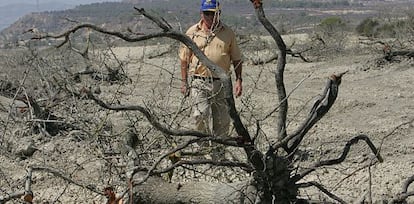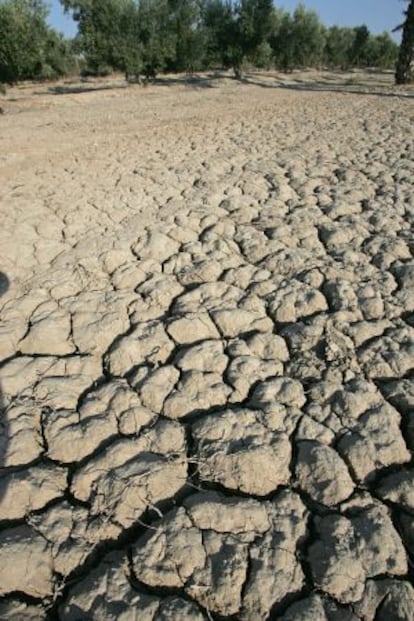The rain in Spain stays away from Alicante
The southeastern province is experiencing its worst drought since 1857, leaving farmers facing ruin


The almond trees of Orihuela, for centuries a feature of the landscape of the dry hinterland of this southern corner of Alicante province, are dying. After they failed to flower this year, local farmers are now pulling them up, dry, stripped bare, as though they had been scorched by fire. So far, more than 180,000 trees have been lost.
The Spanish State Meteorology Agency says barely 100 liters of rain has fallen per square meter (the average is 336) here in the last year, the lowest level since 1857, and the worst figures for anywhere in Spain in 2014. The impact on the province’s unirrigated farmland has been devastating.
Daniel Martínez, now in his late sixties, has been farming in southern Alicante all his life. Looking out over the parched landscape from his farm in Torremundo, close to Orihuela, he pulls his baseball cap down over his eyes to shield himself from the scorching sun. “It hasn’t rained here for 17 months,” he says with calm desperation: “This is the longest drought I have ever seen.” He has already had to pull up 500 of the 7,000 almond trees on his land. As for the remainder, that depends on whether it rains, whether the government steps in to help, or whether there’s a miracle.
Three day-laborers saw up and collect the trunks and branches from uprooted almond trees. It’s highly appreciated for barbecues, which is not much consolation: some of these trees are more than 100 years old, and should produce for up to 60 years.
It hasn’t really rained at all since the fall of 2013. Winter and spring have been extremely dry”
The yellowed, barren landscape is littered with craters where trees have been pulled up. Yet in the distance, it is possible to discern the turquoise waters of La Pedrera reservoir, which is full to overflowing. But the water is kept for plots of land watered by irrigation, not for the so-called secano, the arid land of Alicante’s interior that has to survive on rainfall. “This is not a river drought, it’s a meteorological drought,” says Antonio Gil Olcina, a 71-year-old emeritus professor at the University of Alicante’s geographic analysis department who has been lecturing on climatology for the last 30 years. He says that rains from the Atlantic have fed the reservoirs, and the rivers have brought the water to this corner of Spain. “The drought is hitting the secano very hard,” he says.
Jorge Olcina, head of the University of Alicante’s Climatology Laboratory, concurs, saying that this year, the southwest of the Iberian peninsula has received less rainfall than desert areas such as the Sahel in northern Africa. “This is a historic moment,” he says, pointing out that Alicante has beaten neighboring Murcia’s record of just 89 liters per square meter in 1945. “There has been no humidity from the sea. It hasn’t really rained at all since the fall of 2013. Winter and spring have been extremely dry.” One nearby town, Campello, has had just seven liters of rainfall since January.
“We are living off rain that fell in previous years,” says Olcina, explaining why there have been no water shortages so far, aided by desalination plants and the transfers from the Tagus and Segura rivers to the north.
The lack of rainfall is impacting on the whole ecosystem of the region. More than 30 tons of dead fish were removed from the wetlands of Calpe, Santa Pola and Elche, down on the coast, this summer. “This is the worst summer of my life,” says José María García, who works at the Santa Fe wetlands, a privately owned park on the outskirts of Santa Pola that is home to more than 270 species of birds, fish and other animals. He says the lack of rain means salt levels are rising, reducing oxygen and making it impossible for fish to survive.

García drives slowly round the edges of the dried-out pools. The sun sets, and the flamingos slowly take to the air as the vehicle approaches. “The pools are almost empty now, and the drought is ruining the water,” he says, clutching the wheel. The lack of water brings mud to the surface, forming a thick crust that rots the water and poisons animals. The latest victims seem to be ducks: “They’ve stopped flying, they could be ill.”
Antonio Serrano, who owns the 360-hectare reserve, where around 14 duck hunts are held each year, as well as fishing, says the regional or national government needs to take action: “We need to transfer a minimum of water here so that the fish don’t die. If we don’t get water soon, the birds will leave.”
Local farmers are also calling for the government to do something, saying that it’s not just the almond trees that are dying: citrus fruits, grapes, artichokes and other crops are also desperately in need of water. “Farmers are afraid to plant because they will have to buy even more water,” says Redován Eladio Aniorte, head of a local farmers’ organization. “These increased costs make it impossible to compete.” He estimates the cost of losses as a direct result of the drought this year in Alicante at around €40 million.
The Agriculture Ministry says that it is organizing €40 million in loan guarantees at the national level to deal with the drought. But those affected say they need direct help: “The crops are not getting any water at all, not even from the morning dew: it’s just heat the whole time, and that’s why the plants are not growing, they’re just shrivelling up.”
Tu suscripción se está usando en otro dispositivo
¿Quieres añadir otro usuario a tu suscripción?
Si continúas leyendo en este dispositivo, no se podrá leer en el otro.
FlechaTu suscripción se está usando en otro dispositivo y solo puedes acceder a EL PAÍS desde un dispositivo a la vez.
Si quieres compartir tu cuenta, cambia tu suscripción a la modalidad Premium, así podrás añadir otro usuario. Cada uno accederá con su propia cuenta de email, lo que os permitirá personalizar vuestra experiencia en EL PAÍS.
En el caso de no saber quién está usando tu cuenta, te recomendamos cambiar tu contraseña aquí.
Si decides continuar compartiendo tu cuenta, este mensaje se mostrará en tu dispositivo y en el de la otra persona que está usando tu cuenta de forma indefinida, afectando a tu experiencia de lectura. Puedes consultar aquí los términos y condiciones de la suscripción digital.







































